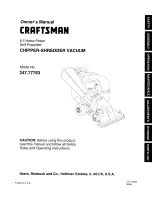
FORM 201.10-NM4
79
YORK INTERNATIONAL
seconds as long as the temperature is below 31°F. If
the temperature rises above 31°F, the micro will inhibit
loading for the remainder of the five minute period.
If, after the five minute period, the saturated suction tem-
perature is above 29°F, the compressor is allowed to re-
load if required to maintain leaving chilled water tempera-
ture. Otherwise, the micro will reset the five minute timer
and start the process over again. To assure that leaving
chilled water requirements are satisfied while one compres-
sor is under Suction Temperature Limiting control, the mi-
cro will start or load other compressor(s) as necessary.
2.4 CHILLER FAULT STATUS MESSAGES
A Chiller Fault will shut the entire chiller down when a
preset safety threshold is exceeded. The chiller will
automatically restart after the condition causing the shut-
down clears. Restart will occur only after anti-recycle
timers are satisfied and demand requires. A reset hys-
teresis is built into each safety so repetitive faulting and
clearing will not occur in a short time period.
Continuous monitoring by the Microprocessor assures
that instantaneous reactions result. When the chiller is
shut down on one of these safeties, a message will
appear on the Status display informing the operator of
the problem as follows:
Low Ambient Temperature:
The Low Ambient Temperature Safety protects the
chiller from running in very low temperatures which could
cause damage due to low system pressures. This fea-
ture is programmable and can be used to shut down
the chiller at a temperature where continued running of
the chiller is not economical compared to the use of
free cooling techniques (see Section 8.2, Low Ambi-
ent Temperature Cutout). The fault will clear when am-
bient temperature rises 1°F above the cut-out.
High Ambient Temperature:
The High Ambient Temperature Safety protects the
chiller from running in ambients above 130°F where the
potential malfunction of system mechanical and electri-
cal components may result. The High Ambient Cutout
is programmable and can be set for lower limit values if
required (see Section 8.2/High Ambient Temperature
Cutout). The fault will clear when ambient temperature
drops 1°F above the cutout.
C H I L L E R
F A U L T :
L O W
A M B I E N T
T E M P
Anticipation controls monitor discharge pressure, mo-
tor current and suction temperature for each compres-
sor and, if maximum limits are approached, the slide
valve loading of the respective compressor will be re-
duced to avoid exceeding the limit.
Displays of anticipation safety control messages and
their meanings are as follows:
Discharge Pressure Limiting:
Discharge Pressure Limiting takes effect when compres-
sor discharge pressure nears the point at which the high
pressure cutout would shut the system down. When the
above message appears, discharge pressure has exceeded
the programmable threshold and the compressor is being
unloaded in an effort to prevent shutdown on the high pres-
sure cutout. The operation of this safety is important if con-
denser coils become dirty, if there is a problem with the
condenser fan operation, or if extreme ambient or load con-
ditions occur (see Section 8.2, High Discharge Pressure
Unload Point for more details).
Compressor Motor Current Limiting:
The Motor Current Limiting message indicates that a com-
pressor motor current has reached a programmable limit
and the system is being unloaded to assure that motor
current does not become excessively high causing a fault
(see Section 8.2, High Average Current Unload Point).
Suction Temperature Limiting:
The Suction Temperature Limiting message applies only
when the chiller is set for Water Cooling Mode (see
Section 3.7). The message indicates that saturated suc-
tion temperature on a system has dropped to 29°F and
that any further temperature reduction could cause some
icing of the evaporator tubes. Saturated suction tem-
perature is computed by the micro by converting suc-
tion pressure to temperature.
For the first 3 minutes that the saturated suction tem-
perature is at or below 29°F any further compressor
loading is inhibited to allow time for the temperature to
rise. If the condition persists for more than three min-
utes, a five minute timer is started. As this timer counts
down to zero, a one second unload pulse will be sent to
the slide valve of the affected compressor every five
S Y S
#
D S C H
L I M I T I N G
S Y S
#
D S C H
L I M I T I N G
S Y S
#
S U C T
L I M I T I N G
S Y S
#
S U C T
L I M I T I N G
S Y S
#
C R N T
L I M I T I N G
S Y S
#
C R N T
L I M I T I N G
C H I L L E R
F A U L T :
H I G H
A M B I E N T
T E M P
















































